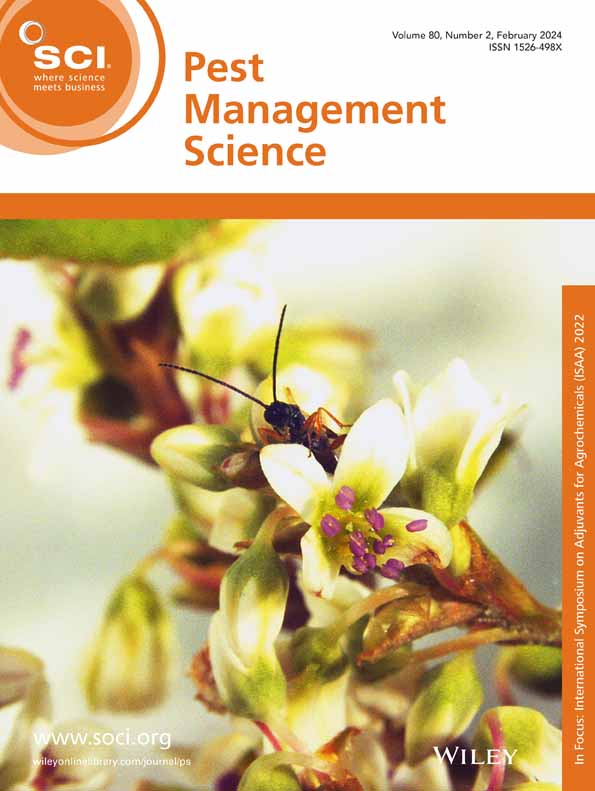Jun Wu, YiHeng Wang, YaXuan Wang, XiaoHong Li, YueYue Li, Miao Zhang, JianHao Xiong, CaiPing Yin, ShuXiang Zhang, XinHua Liu, YingLao Zhang
求助PDF
{"title":"基因组挖掘与OSMAC策略的结合促进了白蚁相关链霉菌tanashiensisBYF‐112产生的生物活性代谢物的发现","authors":"Jun Wu, YiHeng Wang, YaXuan Wang, XiaoHong Li, YueYue Li, Miao Zhang, JianHao Xiong, CaiPing Yin, ShuXiang Zhang, XinHua Liu, YingLao Zhang","doi":"10.1002/ps.8640","DOIUrl":null,"url":null,"abstract":"BACKGROUNDPreviously, eight new alkaloids were obtained from the fermentation extract of termite‐associated <jats:italic>Streptomyces tanashiensis</jats:italic> BYF‐112. However, genome analysis indicated the presence of many undiscovered secondary metabolites in <jats:italic>S. tanashiensis</jats:italic> BYF‐112.RESULTSHerein, 12 new alkaloids, tianwuine A–E (1–5), cephalandole C (6), venezuelines I–L (7–10), <jats:italic>N</jats:italic>‐(4‐methylphenyl‐2‐hydroxy) formamide (11) and <jats:italic>N</jats:italic>‐(5‐formyl‐2‐hydroxyphenyl) formamide (12), as well as three known metabolites (13–15) were discovered from BYF‐112 based on a combination of genome mining and the one strain many compounds (OSMAC) strategy. Plausible biosynthetic pathways of 1–13 were proposed using bioinformatic analysis of the full genome of BYF‐112. Partial metabolites were evaluated <jats:italic>in vitro</jats:italic> for their antibacterial, phytotoxic, and anti‐inflammatory activities. Pyrroloformamide A (14) showed strong antibacterial activities against <jats:italic>Staphylococcus aureus</jats:italic>, methicillin‐resistant <jats:italic>Staphylococcus aureus</jats:italic>, <jats:italic>Pseudomonas syringae</jats:italic> pv. <jats:italic>actinidae</jats:italic>, <jats:italic>Xanthomonas oryzae</jats:italic> pv. <jats:italic>oryzae</jats:italic> and <jats:italic>Xanthomonas oryzae</jats:italic> pv. <jats:italic>oryzicola</jats:italic> at a concentration of 50 μg per 6 mm disk. Simultaneously, pyrroloformamide A (14) also had a strong inhibitory effect on the radicle growth of <jats:italic>Echinochloa crusgalli</jats:italic> with an inhibition rate of 98.01% at a concentration of 100 μg/mL, equivalent to the positive 2,4‐dichlorophenoxyacetic acid. Subsequently, the possible herbicidal mechanism of 14 was explored using molecular docking simulation. In addition, venezueline G (13) displayed a strong inhibitory effect of NO production, with an half‐maximal inhibitory concentration (IC<jats:sub>50</jats:sub>) value of 2.3 μ<jats:sc>m</jats:sc>, which was comparable with that of BAY 11‐7082 with an IC<jats:sub>50</jats:sub> value of 2.1 μ<jats:sc>m</jats:sc>.CONCLUSIONThese findings revealed a perspective for the development of novel bioactive drugs in the food, agricultural, and biomedical fields utilizing the metabolites of BYF‐112. © 2025 Society of Chemical Industry.","PeriodicalId":218,"journal":{"name":"Pest Management Science","volume":"6 1","pages":""},"PeriodicalIF":3.8000,"publicationDate":"2025-01-11","publicationTypes":"Journal Article","fieldsOfStudy":null,"isOpenAccess":false,"openAccessPdf":"","citationCount":"0","resultStr":"{\"title\":\"A combination of genome mining with OSMAC strategy facilitates the discovery of bioactive metabolites produced from termite‐associated Streptomyces tanashiensisBYF‐112\",\"authors\":\"Jun Wu, YiHeng Wang, YaXuan Wang, XiaoHong Li, YueYue Li, Miao Zhang, JianHao Xiong, CaiPing Yin, ShuXiang Zhang, XinHua Liu, YingLao Zhang\",\"doi\":\"10.1002/ps.8640\",\"DOIUrl\":null,\"url\":null,\"abstract\":\"BACKGROUNDPreviously, eight new alkaloids were obtained from the fermentation extract of termite‐associated <jats:italic>Streptomyces tanashiensis</jats:italic> BYF‐112. However, genome analysis indicated the presence of many undiscovered secondary metabolites in <jats:italic>S. tanashiensis</jats:italic> BYF‐112.RESULTSHerein, 12 new alkaloids, tianwuine A–E (1–5), cephalandole C (6), venezuelines I–L (7–10), <jats:italic>N</jats:italic>‐(4‐methylphenyl‐2‐hydroxy) formamide (11) and <jats:italic>N</jats:italic>‐(5‐formyl‐2‐hydroxyphenyl) formamide (12), as well as three known metabolites (13–15) were discovered from BYF‐112 based on a combination of genome mining and the one strain many compounds (OSMAC) strategy. Plausible biosynthetic pathways of 1–13 were proposed using bioinformatic analysis of the full genome of BYF‐112. Partial metabolites were evaluated <jats:italic>in vitro</jats:italic> for their antibacterial, phytotoxic, and anti‐inflammatory activities. Pyrroloformamide A (14) showed strong antibacterial activities against <jats:italic>Staphylococcus aureus</jats:italic>, methicillin‐resistant <jats:italic>Staphylococcus aureus</jats:italic>, <jats:italic>Pseudomonas syringae</jats:italic> pv. <jats:italic>actinidae</jats:italic>, <jats:italic>Xanthomonas oryzae</jats:italic> pv. <jats:italic>oryzae</jats:italic> and <jats:italic>Xanthomonas oryzae</jats:italic> pv. <jats:italic>oryzicola</jats:italic> at a concentration of 50 μg per 6 mm disk. Simultaneously, pyrroloformamide A (14) also had a strong inhibitory effect on the radicle growth of <jats:italic>Echinochloa crusgalli</jats:italic> with an inhibition rate of 98.01% at a concentration of 100 μg/mL, equivalent to the positive 2,4‐dichlorophenoxyacetic acid. Subsequently, the possible herbicidal mechanism of 14 was explored using molecular docking simulation. In addition, venezueline G (13) displayed a strong inhibitory effect of NO production, with an half‐maximal inhibitory concentration (IC<jats:sub>50</jats:sub>) value of 2.3 μ<jats:sc>m</jats:sc>, which was comparable with that of BAY 11‐7082 with an IC<jats:sub>50</jats:sub> value of 2.1 μ<jats:sc>m</jats:sc>.CONCLUSIONThese findings revealed a perspective for the development of novel bioactive drugs in the food, agricultural, and biomedical fields utilizing the metabolites of BYF‐112. © 2025 Society of Chemical Industry.\",\"PeriodicalId\":218,\"journal\":{\"name\":\"Pest Management Science\",\"volume\":\"6 1\",\"pages\":\"\"},\"PeriodicalIF\":3.8000,\"publicationDate\":\"2025-01-11\",\"publicationTypes\":\"Journal Article\",\"fieldsOfStudy\":null,\"isOpenAccess\":false,\"openAccessPdf\":\"\",\"citationCount\":\"0\",\"resultStr\":null,\"platform\":\"Semanticscholar\",\"paperid\":null,\"PeriodicalName\":\"Pest Management Science\",\"FirstCategoryId\":\"97\",\"ListUrlMain\":\"https://doi.org/10.1002/ps.8640\",\"RegionNum\":1,\"RegionCategory\":\"农林科学\",\"ArticlePicture\":[],\"TitleCN\":null,\"AbstractTextCN\":null,\"PMCID\":null,\"EPubDate\":\"\",\"PubModel\":\"\",\"JCR\":\"Q1\",\"JCRName\":\"AGRONOMY\",\"Score\":null,\"Total\":0}","platform":"Semanticscholar","paperid":null,"PeriodicalName":"Pest Management Science","FirstCategoryId":"97","ListUrlMain":"https://doi.org/10.1002/ps.8640","RegionNum":1,"RegionCategory":"农林科学","ArticlePicture":[],"TitleCN":null,"AbstractTextCN":null,"PMCID":null,"EPubDate":"","PubModel":"","JCR":"Q1","JCRName":"AGRONOMY","Score":null,"Total":0}
引用次数: 0
引用
批量引用
A combination of genome mining with OSMAC strategy facilitates the discovery of bioactive metabolites produced from termite‐associated Streptomyces tanashiensisBYF‐112
BACKGROUNDPreviously, eight new alkaloids were obtained from the fermentation extract of termite‐associated Streptomyces tanashiensis BYF‐112. However, genome analysis indicated the presence of many undiscovered secondary metabolites in S. tanashiensis BYF‐112.RESULTSHerein, 12 new alkaloids, tianwuine A–E (1–5), cephalandole C (6), venezuelines I–L (7–10), N ‐(4‐methylphenyl‐2‐hydroxy) formamide (11) and N ‐(5‐formyl‐2‐hydroxyphenyl) formamide (12), as well as three known metabolites (13–15) were discovered from BYF‐112 based on a combination of genome mining and the one strain many compounds (OSMAC) strategy. Plausible biosynthetic pathways of 1–13 were proposed using bioinformatic analysis of the full genome of BYF‐112. Partial metabolites were evaluated in vitro for their antibacterial, phytotoxic, and anti‐inflammatory activities. Pyrroloformamide A (14) showed strong antibacterial activities against Staphylococcus aureus , methicillin‐resistant Staphylococcus aureus , Pseudomonas syringae pv. actinidae , Xanthomonas oryzae pv. oryzae and Xanthomonas oryzae pv. oryzicola at a concentration of 50 μg per 6 mm disk. Simultaneously, pyrroloformamide A (14) also had a strong inhibitory effect on the radicle growth of Echinochloa crusgalli with an inhibition rate of 98.01% at a concentration of 100 μg/mL, equivalent to the positive 2,4‐dichlorophenoxyacetic acid. Subsequently, the possible herbicidal mechanism of 14 was explored using molecular docking simulation. In addition, venezueline G (13) displayed a strong inhibitory effect of NO production, with an half‐maximal inhibitory concentration (IC50 ) value of 2.3 μm , which was comparable with that of BAY 11‐7082 with an IC50 value of 2.1 μm .CONCLUSIONThese findings revealed a perspective for the development of novel bioactive drugs in the food, agricultural, and biomedical fields utilizing the metabolites of BYF‐112. © 2025 Society of Chemical Industry.

 求助内容:
求助内容: 应助结果提醒方式:
应助结果提醒方式:


